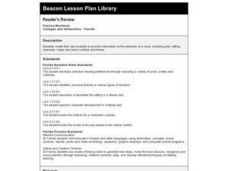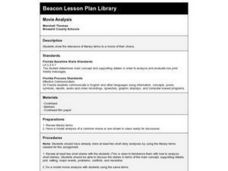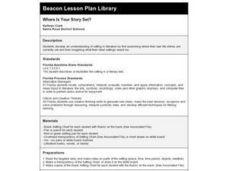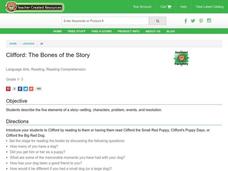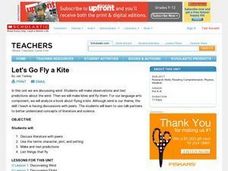Curated OER
Reader's Review
Students create booklets to provide information on elements of a novel, including plot, setting, character, major and minor conflicts and theme.
Curated OER
Movie Analysis
Fourth graders discuss main concept, supporting details, plot, setting, major events, problems, conflicts, and resolution in two short stories. They apply these terms to a movie of their choice. They compare analysis of movies to...
Curated OER
Where Is Your Story Set?
Students explore the concept of setting in literature by identifying their own current setting, and imagining what their ideal setting would be. They read a piece of literature, identify the setting and record the information on a chart.
Curated OER
Introducing Mythology
Students look closely at a poster of a Rembrandt painting and/or a transparency of a Greek vase, both of which represent the mythological story of the abduction of Europa. Studnets consider how two artists interpreted the same subject in...
Curated OER
The Crucible
Twelfth graders use an Internet scavenger hunt, vocabulary, sample essay questions, and short answer questions suitable for study and review of the play, The Crucible.
Curated OER
Egg Carton Stories
Students create stories with better structure when they are able to focus on its characters, setting, and plot. Teacher creates settings, character, and problem cartons with information written on strips of paper.
Curated OER
The Bones of the Story
Young scholars describe the five elements of a story--setting, characters, problem, events, and resolution. They use the Clifford series of books, and a worksheet imbedded in this lesson to help them explain the five elements of a story.
Curated OER
Story Blender
Fifth graders write a story with many paragraphs that include a plot, setting, and ending. In this writing lesson plan, 5th graders create stories as a class.
Curated OER
Comprehension: Setting
Students discuss what setting represents. In this language arts lesson, students review the three elements of setting: where the story takes place, when does the story take place, and is it past, present, or future? Students create a...
Curated OER
The Fall of the House of Usher by Edgar Allan Poe
Learners explore "The Fall of the House of Usher" by Edgar Allan Poe. For this literature lesson, students read the story and take notes. Learners choose a literary element such as character, setting, or theme. Students write an essay...
Curated OER
Gilbert Munger Lesson Plan Ideas
Students read the biography of Gilbert Munger and analyze art that reflects the beauty of nature. In this art analysis instructional activity, students view a realistic image of Salt Lake City and lake over 100 years ago.
Curated OER
School-Home Links? Book Links 91
In this setting worksheet, students select a book, note the title and author, read the book with a family member and then draw a picture of the story's setting. Parents or guardians must sign the worksheet.
Curated OER
Multimedia Final Project
High schoolers work with a partner to compile a new movie. They comprehend tat the movie requres a lot of preparation and media releases. Students use one computer, create the serval different materials for their film: A Publisher...
Curated OER
Science: Let's Fly a Kite!
Students make observations about the wind and develop predictions to test with kites. The lesson's Language Arts component invloves communication of concepts with peers. On their kite flying day, students discuss how the wind and air...
Curated OER
The Librarian from Conneaut School
Second graders identify the elements of the story "The Librarian from the Black Lagoon." They listen to the story and list the story elements of character, settling, problem, and solution. They then use KidPix to create individual...
Curated OER
Bridge to Terabithia
Students read Katherine Paterson's book, A Bridge to Terabithia, and select small groups to complete a project based on a chapter of the book. They create a story web for the chapter, summarize it, design a brochure or advertisement,...
Curated OER
Cuentos
Students revise Spanish mystery stories. They sequence the events from a group's mystery story and suggest revisions for the setting. They revise their stories using the suggestions from classmates and describe characters in folktales....
Curated OER
The Lion, The Witch, and The Wardrobe: A Literature Evaluation Project
Sixth graders read and analyze The Lion, The Witch, and The Wardrobe. They study the elements of literature found in the book. Students create an elements of literature flip book that shows the various elements of literature in the novel.
Curated OER
Multicultural Fairy Tales
Third graders explore the elements of a story using fairy tales from all over the world. They compare and contrast story elements, key ideas and concepts found in a variety of texts from around the world.
Curated OER
Narrative Strategies
Sixth graders explore strategies authors use to make characters and setting seem real to readers. They develop characters and describe setting in original narratives. Students read myths and determine common themes found in myths from...
Curated OER
Literature: Mapping the Mockingbird
Students read Harper Lee's To Kill a Mockingbird, focusing on setting. They list items that create mental images of the novel's setting along with location references to characters and events. Using posterboard, they construct physical...
Curated OER
Story Stew -- Teaching Character, Plot, And Setting
Students examine the story elements of characters, plot, and setting. They identify the story elements from various "ingredients" taken out of a pot, and add their own story element "ingredients" on index cards into the pot.
Curated OER
Lesson Plan for Day Two Part One of Unit on Bless Me, Ultima
Tenth graders prepare to read Bless Me, Ultima as they study the Southwestern region of the United States. They examine the characters, setting, and culture by using context clues, and participate in a jigsaw activity.
Curated OER
Writing a Mystery Story
Students examine the elements of mystery stories and read Rage in Harlem. In reciprocal teaching groups, they discuss the author's development of the story, and complete dialectical journals.


